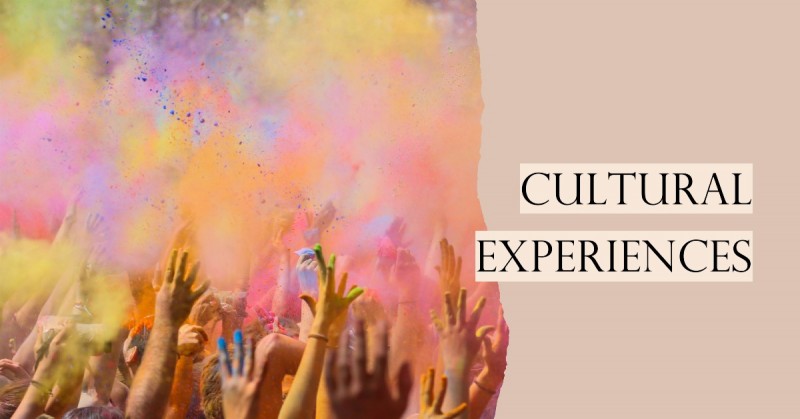
India is a land of rich cultural heritage, known for its diverse traditions, festivals, and artistic expressions. The country's cultural tapestry is interwoven with a myriad of festivals, captivating dance forms, and enchanting music. In this article, we will embark on a journey to explore some of the most prominent Indian festivals, traditional dance forms, and captivating music genres.
Indian Festivals
Diwali
Diwali, also known as the Festival of Lights, is one of the most widely celebrated festivals in India. It signifies the victory of light over darkness and good over evil. During Diwali, people illuminate their homes with earthen lamps called "diyas" and colorful lights. Fireworks fill the night sky, and families come together to exchange gifts, share delicious sweets, and perform prayers. Diwali is a time of joy, positivity, and the celebration of life's blessings.
Holi
Holi, known as the Festival of Colors, is a vibrant and exuberant festival celebrated with great enthusiasm throughout India. It marks the arrival of spring and celebrates the triumph of good over evil. People come together to throw colored powders and water at each other, creating a spectacle of joyful chaos. Holi breaks social barriers, bringing people from different backgrounds and communities together in a riot of colors, laughter, and merriment.
Navratri
Navratri, meaning "nine nights," is a festival dedicated to the worship of the Hindu goddess Durga. It is celebrated with fervor and devotion in various parts of India. During Navratri, people engage in traditional dance forms, particularly Garba and Dandiya Raas, accompanied by lively music. The festival is a vibrant display of colorful costumes, rhythmic movements, and joyful celebrations. It embodies the spirit of unity, devotion, and cultural pride.
Traditional Dance Forms
Bharatanatyam
Bharatanatyam is a classical dance form originating from the state of Tamil Nadu in southern India. It is characterized by intricate footwork, expressive gestures, and elaborate facial expressions. Bharatanatyam combines elements of music, rhythm, and storytelling to depict mythological tales and devotional themes. The dance form has a rich history and is known for its grace, precision, and emotive storytelling.
Kathak
Kathak is a classical dance form that evolved in the northern regions of India. It is known for its intricate footwork, rapid spins, and graceful movements. Kathak combines elements of storytelling, rhythm, and expressive gestures. The dance form reflects the cultural influences of both Hindu and Muslim traditions, creating a unique blend of artistic expression. Kathak mesmerizes the audience with its lyrical beauty and rhythmic patterns.
Odissi
Odissi is a classical dance form from the state of Odisha in eastern India. It is characterized by fluid movements, intricate postures, and graceful expressions. Odissi draws inspiration from ancient temple sculptures and portrays mythological stories and devotional themes. The dance form is known for its captivating grace, delicate hand gestures, and dynamic footwork. Odissi captures the essence of spirituality and devotion through its enchanting performances.
Indian Music
Carnatic
Carnatic music is a classical music tradition predominantly practiced in the southern regions of India. It is known for its intricate melodic patterns, rhythmic structures, and soulful renditions. Carnatic music is based on a system of ragas (melodic scales) and talas (rhythmic cycles). The performances often involve vocalists accompanied by instruments such as the violin, mridangam (percussion), and veena (stringed instrument). Carnatic music invokes deep emotions and takes the listener on a profound musical journey.
Hindustani
Hindustani music is a classical music tradition widely practiced in North India. It has its roots in ancient Vedic traditions and Islamic influences. Hindustani music is characterized by improvisation, intricate ornamentations, and a deep emotional connect. It encompasses various forms, such as dhrupad, khayal, thumri, and ghazal. Hindustani music is performed by vocalists and instrumentalists, with instruments like sitar, tabla, sarangi, and bansuri (flute). It evokes a range of emotions, from tranquility to ecstasy.
Conclusion
Indian culture offers a treasure trove of cultural experiences through its festivals, dance forms, and music. The festivals of Diwali, Holi, and Navratri bring people together in celebration, fostering a sense of unity and joy. The traditional dance forms of Bharatanatyam, Kathak, and Odissi captivate with their expressive movements and intricate storytelling. Meanwhile, the music genres of Carnatic and Hindustani take us on a melodic journey, evoking profound emotions. Exploring Indian festivals, dance forms, and music provides a glimpse into the rich heritage and artistic brilliance of this diverse nation.
Popular TV Shows: Discussing the Most Popular and Successful Television Shows in India
Film Awards in Bollywood: Discussing Prestigious Awards and Their Impact on the Industry
History of Bollywood: Explore the Origins of Bollywood and Its Evolution